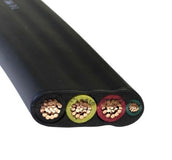How Many Amps For 10 Gauge Wire?
How Many Amps For 10 Gauge Wire?
The general ampacity of a 10 AWG copper wire is 30 Amps at 60°C/140°F, 35 Amps at 75°C/167°F, and 40 Amps at 90°C/194°F. Here is it broken down according to the type of cable insulation:
- With 60°C insulation (such as TW or UF), the ampacity is 30 amps.
- With 75°C insulation (like RHW, THHW, THWN), the ampacity is 35 amps.
- With 90°C insulation (such as THHN or XHHW), the ampacity is 40 amps.
What Is The Ampacity of 10 AWG Aluminum Wire?
The ampacity of 10 AWG aluminum wire, according to NEC 2020, is the following:
- With 60°C insulation (such as TW or UF), the ampacity is approximately 25 amps.
- With 75°C insulation (like RHW, THHW, THWN), the ampacity is around 30 amps.
- With 90°C insulation (such as THHN or XHHW), the ampacity can be up to 35 amps.

What Are The Common Applications of 10 AWG Cables?
10 AWG cables are primarily designed for large household appliances, HVAC units, and heavy-duty power tools.
Here is the list of common applications of 10 AWG cables:
- Branch Circuits for Outlets and Switches: In residential wiring, 10 AWG cables are often used for outlets and switches in rooms that require higher current, such as kitchens or laundry rooms.
- Large Appliances: These cables are suitable for wiring large appliances that require a higher current, like air conditioners, refrigerators, and freezers.
- Small Air Conditioning Units: 10 AWG cables can be used for smaller air conditioning units that don't require the capacity of larger gauge wires.
- Electric Water Heaters: Some smaller or single-element electric water heaters can be connected with 10 AWG wire, provided the amperage load aligns with the wire's capacity.
- Outdoor and Underground Runs: Including powering outdoor lighting or outbuildings.
- Solar Panel Arrays: In renewable energy systems, such as solar panel installations, 10 AWG wire is commonly used for connecting solar panels to the inverter or combiner boxes. This is mostly true for smaller residential systems.
Common Types of 10 AWG Cables
Below are some of the most popular types of 10 AWG Cables:
- THHN/THWN: Commonly used in residential and commercial building wiring for outlets, switches, and light fixtures. In gauge 10, THHN/THWN cables are suitable for higher current applications in dry (THHN) and damp (THWN) environments.
- UF-B: As a 10 AWG cable, UF-B is ideal for direct burial outdoor applications like garden lighting, power to outbuildings, or other outdoor applications.
- NM-B: In 10 AWG, NM-B (Romex) is typically used for wiring large appliances, and air conditioning units. It is a cable meant for dry indoor settings.
- XHHW: The 10 AWG version is used in both dry and wet locations, suitable for power distribution in residential and commercial buildings.
- USE-2/RHH/RHW-2: In solar panel installations, outdoor lighting, and other outdoor or underground applications, 10 AWG cables are used for their durability and suitability for direct burial.
- MC: The 10 AWG Metal Clad cable is often used in commercial and industrial settings for machinery and equipment wiring. It is used when additional protection is needed.
- TECK90: The 10 AWG version is particularly suited for industrial applications in Canada, including in factories or plants.




























